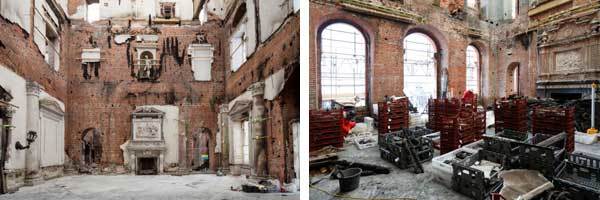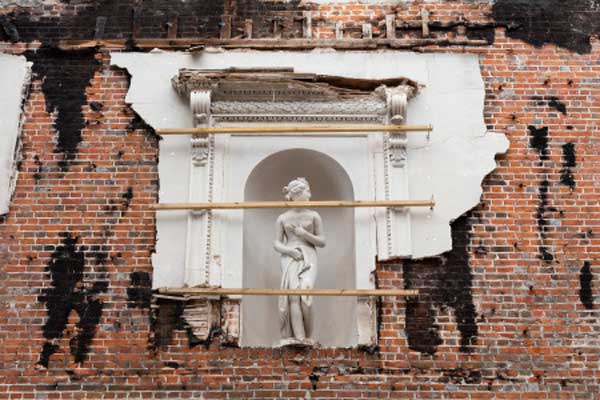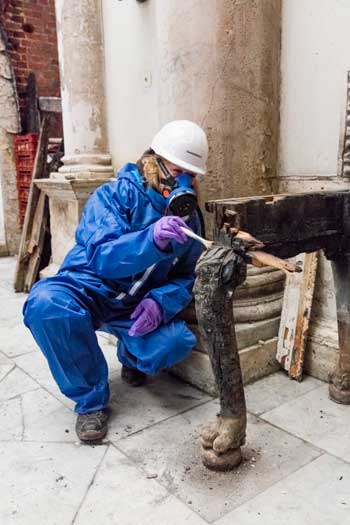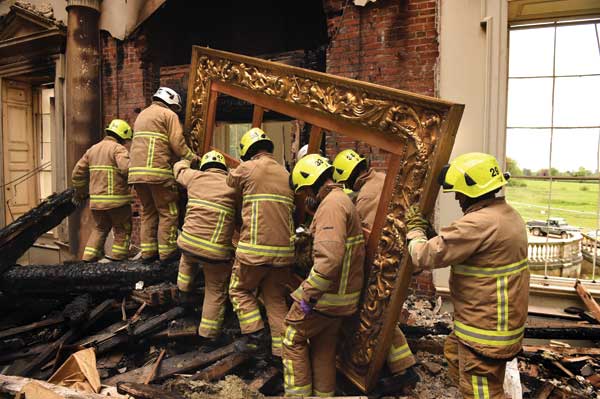The National Trust will restore the most significant ground floor rooms to their original glory and the upper floors to become flexible, modern spaces. The competition to find the designer will be launched later in 2016. Clandon Park’s gardens will be restored as well, to their original design from when the house was built.
The National Trust today announced ambitious plans to bring a fire-ravaged Palladian mansion back to life in what will be the charity’s biggest conservation project in a generation.
Clandon Park, an 18th century stately home, near Guildford, Surrey, was hit by a devastating fire, which ripped through the building last April.
The conservation charity today outlined plans to restore the house’s most architecturally and historically significant rooms on the ground floor while at the same time creating vibrant, modern spaces, which would breathe new life into the house.

L: The Marble Hall at Clandon, following the removal of the debris and the stabilisation of the remaining wall surfaces. ©National Trust Images/James Dobson. R: Crates with salvaged fragments in the Saloon. ©National Trust Images/James Dobson
A competition will be held later this year to find the right architect to bring the space alive in a bold and imaginative way.
The Trust said it was now confident a number of principal rooms on the ground floor – including the Marble Hall, Speakers’ Parlour and Saloon – could and should be restored given their architectural and historical significance.
The fact that so many features survived and items from the rooms are being recovered from the ashes made the case for restoration compelling. But the Trust said it was not looking to recreate the rooms as they were the day before the fire. The enduring significance of the architect Leoni’s original designs means it will go back instead to look at the 18th century decorative schemes and layout of the house. The Trust will discuss the restoration plans with specialists and a number of conservation bodies over the coming months.
On the upper floors, the Trust said that the rooms were less architecturally significant and had been considerably altered over the centuries. So the proposal is for these floors to be transformed to create flexible spaces which could be used for exhibitions, events and performances.
Members, visitors, specialists and the general public would be encouraged to get involved and comment on a short-list of design options.
The Trust is also proposing to return the gardens to how they were designed when the house was originally built.

A plaster cast of a statue of Venus, still in situ in the Marble Hall. ©National Trust Images/James Dobson
Helen Ghosh, the Trust’s director general, said: “Today marks an exciting new chapter in the Clandon story, and will represent one of most ambitious projects ever undertaken by the National Trust.
“The fire at Clandon was shocking, but gives us the opportunity not only to show our respect for the heritage of the past, but also to create new heritage for the future.
“Our plans involve returning parts of the house to its 18th century glory whilst at the same time creating a building of beauty and relevance for the 21st century.
“Given their historic and cultural significance, and the fact so many original features have survived, we believe we should restore the magnificent state rooms on the ground floor – the most architecturally important and beautiful rooms.
“This element of the project will also enable us to draw on the wealth of expertise within the Trust and beyond to utilise and develop traditional skills which are in grave danger of being lost.
“In the floors above, we can approach the design with more freedom and adapt the space, both architecturally and in its function, so that we can use it for exhibitions and events that bring our treasures and stories to a wide range of audiences.
“Recent research has also given us a wonderful picture of the original 18th century gardens, and so resources permitting, we also hope to bring those back to life in the spirit of a project that will both look back to the best of the past and create an exciting future”.

Conservator cleaning the remains of a side table in the Marble Hall. ©National Trust Images/James Dobson
One of Clandon’s most important rooms – the Speakers’ Parlour – suffered only minor damage in the blaze and the entire external structure of the house as conceived by its Venetian architect remains in place.
Major architectural features such as fireplaces, panelling and decorative plasterwork survive in a number of rooms, including the magnificent marble chimney pieces and over mantels by the renowned sculptor John Michael Rysbrack in the Marble Hall.
Over the last nine months, the Trust reviewed a number of options for Clandon, ranging from leaving it as a ruin to a full restoration. It looked carefully at the architectural significance of what had survived the fire, the items salvaged from the building and what was technically possible within it.
It also applied a set of criteria, based on the charity’s core purpose, to guide its thinking. This included: ensuring Clandon Park remained open and accessible to the public; reflected Clandon’s historic and cultural significance; and generated enough income to maintain its long-term conservation.
The cost of the project is expected to be met largely through the Trust’s insurance policy – although not in its entirety. Once its plans are at a more advanced stage, the charity said it would be asking supporters for help.




